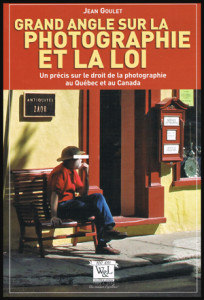(Un précis sur le droit de la photographie au Québec et au Canada)

For those of you who can read French, here is a very interesting handbook. The author, Jean Goulet, is a lawyer by profession and was a full time teacher at the University Laval Faculty of Law in Québec. Himself an amateur photographer, he decided to develop on the many legal questions pertinent to amateur and professional photography.
The author skims through national and international legislation and takes a moment to discuss the Berne Convention. He uses real life examples in order to help the photographer understand the legal consequences of his actions when taking a picture.
Mr Goulet uses Canadian, Québec, French, American and English jurisprudence to highlight the legal aspects in the Aubry, Théberge, Snow, Roby, Ateliers Tango argentin, Xprima affairs, etc.
The reader is informed as to copyright, counterfeiting, reproduction of photos legal limitations, as well as monetary compensation granted regarding defamation. The amateur or professional photographer can learn about the legal obligations pertaining to filming of taking pictures during a show or a theater piece. Details are also provided for anyone interested into photographing animals, expensive private properties, people on a private or public lot, political figures, etc.
Many other aspects are brought forward in this really well done handbook but I cannot present them all in a short article. All you should know is that it is easy to find the information you need and that reading this handbook will help you to take informed decisions before taking pictures.
Here are few points, among many more present in the book that a photographer should know:
[My translation] “The right to take pictures in a private property exists as long as the property owner gives you his authorisation, or is non-existent when the law strictly forbids it”.
[My translation] “ Everybody possessing a personal and exclusive right on his image, nobody can photograph a person and transfer the photo in the public domain without the person’s personal consent, if the photographed person can be recognized and if that person does not hold in the scene a role that is only an accessory role ”.
As well, [My translation] “ If the photographed person is a minor, the photographer will have to obtain the full consent from the child’s parents in order to publish the photo; if the parents cannot come to an agreement, the case will have to be brought to Court (a.604 C.c.Q) ”.
When it comes to copyright: [My translation] “ Photographers hold a copyright as soon as they have used the camera shutter, this copyright protecting their economic rights and including a moral right that they keep even if they have sold copies of their original work, unless they have explicitly gave up that privilege ”.
[My translation]: “Owner or holder of rights, the independent photographer still remains the only master of the photography he created. It is the basic rule when it comes to ownership or rights linked to photography”.
Title : Grand angle sur la photographie et la loi
Author : Jean Goulet
©Wilson&Lafleur Ltée, Montréal, 2010
ISBN : 978-2-89127-972-7